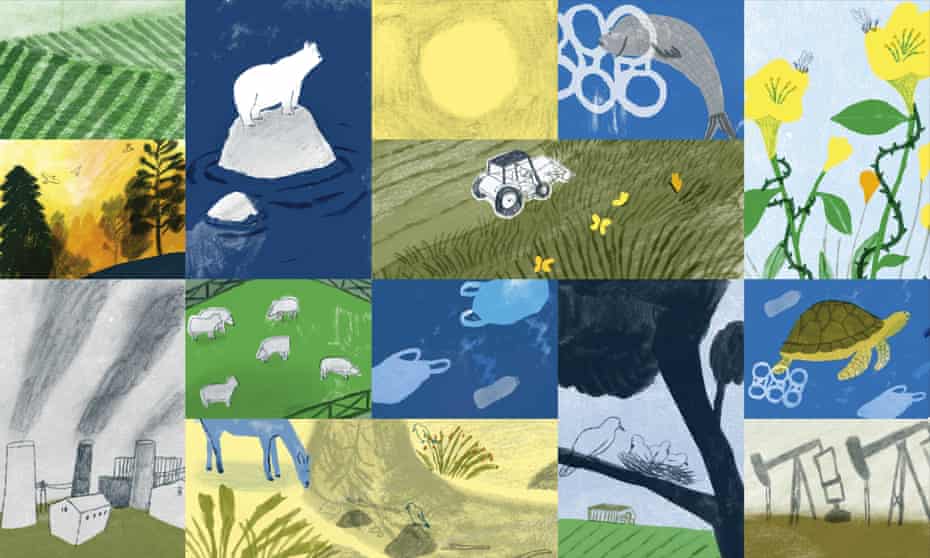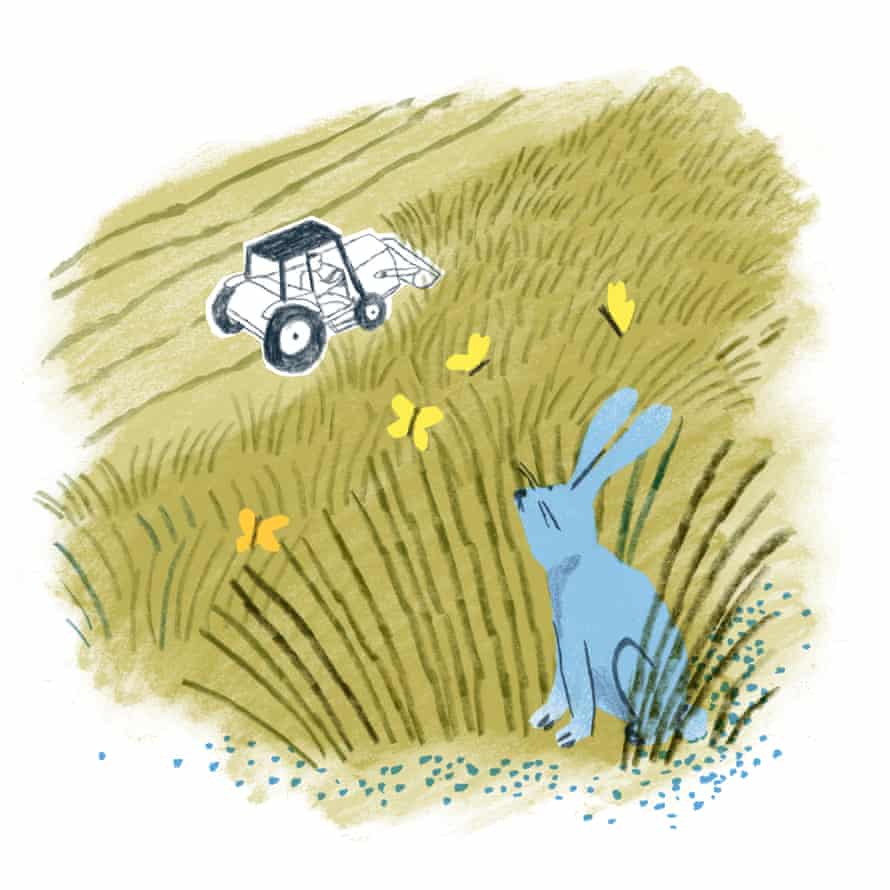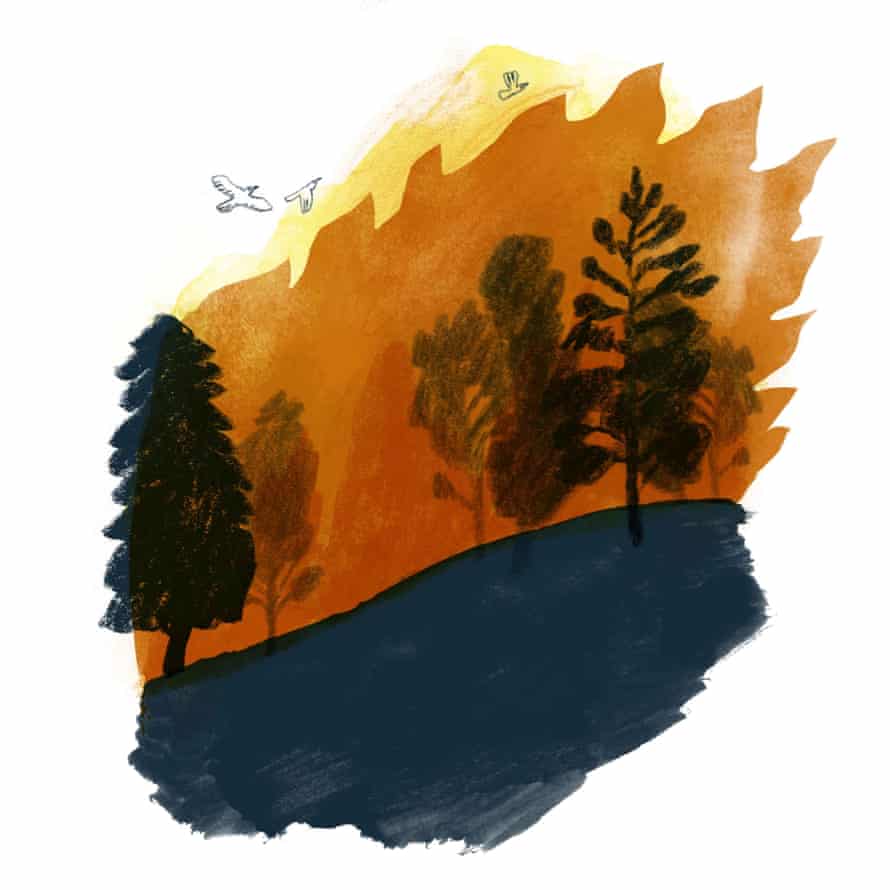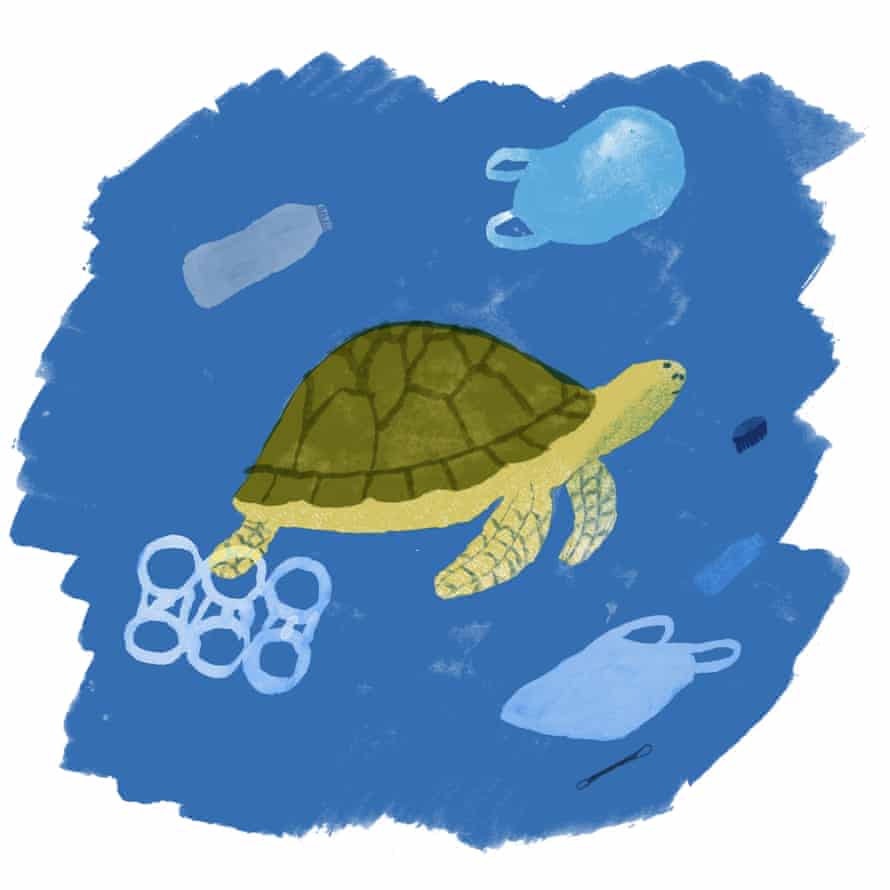The five biggest threats to our natural world … and how we can stop them

From destructive land use to invasive species, scientists have identified the main drivers of biodiversity loss – so that countries can collectively act to tackle them
Last modified on Thu 14 Oct 2021 08.37 EDT
The world’s wildlife populations have plummeted by more than two-thirds since 1970 – and there are no signs that this downward trend is slowing. The first phase of Cop15 talks in Kunming this week will lay the groundwork for governments to draw up a global agreement next year to halt the loss of nature. If they are to succeed, they will need to tackle what the IPBES (Intergovernmental Science-Policy Platform on Biodiversity and Ecosystem Services) has identified as the five key drivers of biodiversity loss: changes in land and sea use; direct exploitation of natural resources; climate change; pollution; and invasion of alien species.
Changes in land and sea use

Clearing the US prairies: ‘On a par with tropical deforestation’
“It’s hidden destruction. We’re still losing grasslands in the US at a rate of half a million acres a year or more.”
Tyler Lark, from the University of Wisconsin-Madison, knows what he is talking about. Lark and a team of researchers used satellite data to map the expansion and abandonment of land across the US and discovered that 4m hectares (10m acres) had been destroyed between 2008 and 2016.
Large swathes of the United States’ great prairies continue to be converted into cropland, according to the research, to make way for soya bean, corn and wheat farming.
Changes in land and sea use has been identified as the main driver of “unprecedented” biodiversity and ecosystem change over the past 50 years. Three-quarters of the land-based environment and about 66% of the marine environment have been significantly altered by human actions.
North America’s grasslands – often referred to as prairies – are a case in point. In the US, about half have been converted since European settlement, and the most fertile land is already being used for agriculture. Areas converted more recently are sub-prime agricultural land with yields 70% lower than the national average, which means a lot of biodiversity is being lost for diminishing returns.
“Our findings demonstrate a pervasive pattern of encroachment into areas that are increasingly marginal for production but highly significant for wildlife,” Lark and his team wrote in the paper, published in Nature Communications.
Boggier areas of land, or those with uneven terrain, were traditionally left as grassland, but in the past few decades, this marginal land has also been converted. In the US, 88% of cropland expansion takes place on grassland, and much of this is happening in the Great Plains – known as America’s breadbasket – which used to be the most extensive grassland in the world.
Q&AWhat are the five biggest threats to biodiversity?Show
According to the UN’s Convention on Biological Diversity there are five main threats to biodiversity. In descending order these are: changes in land and sea use; direct exploitation of natural resources; climate change; pollution and invasive species.
1. For terrestrial and freshwater ecosystems, land-use change has had the largest relative negative impact on nature since 1970. More than a third of the world’s land surface and nearly 75% of freshwater resources are now devoted to crop or livestock production. Alongside a doubling of urban area since 1992, things such as wetlands, scrubland and woodlands – which wildlife relies on – are ironed out from the landscape.
2. The direct exploitation of organisms and non-living materials, including logging, hunting
and fishing and the extraction of soils and water are all negatively affecting ecosystems. In marine environments, overfishing is considered to be the most serious driver of biodiversity loss. One quarter of the world’s commercial fisheries are overexploited, according to a 2005 Millennium Ecosystem Assessment.
3. The climate crisis is dismantling ecosystems at every level. Extreme weather events such as tropical storms and flooding are destroying habitats. Warmer temperatures are also changing the timing of natural events – such as the availability of insects and when birds hatch their eggs in spring. The distribution of species and their range is also changing.
4. Many types of pollution are increasing. In marine environments, pollution from agricultural runoff (mainly nitrogen and phosphorus) do huge damage to ecosystems. Agricultural runoff causes toxic algal blooms and even “dead zones” in the worst affected areas. Marine plastic pollution has increased tenfold since 1980,
affecting at least 267 species.
5. Since the 17th century, invasive species have contributed to 40% of all known animal extinctions. Nearly one fifth of the Earth’s surface is at risk of plant and animal invasions. Invasive species change the composition of ecosystems by outcompeting native species.
Hotspots for this expansion have included wildlife-rich grasslands in the “prairie pothole” region which stretches between Iowa, Dakota, Montana and southern Canada and is home to more than 50% of North American migratory waterfowl, as well as 96 species of songbird. This cropland expansion has wiped out about 138,000 nesting habitats for waterfowl, researchers estimate.
These grasslands are also a rich habitat for the monarch butterfly – a flagship species for pollinator conservation and a key indicator of overall insect biodiversity. More than 200m milkweed plants, the caterpillar’s only food source, were probably destroyed by cropland expansion, making it one of the leading causes for the monarch’s national decline.
The extent of conversion of grassland in the US makes it a larger emission source than the destruction of the Brazilian Cerrado, according to research from 2019. About 90% of emissions from grassland conversion comes from carbon lost in the soil, which is released when the grassland is ploughed up.
“The rate of clearing that we’re seeing on these grasslands is on par with things like tropical deforestation, but it often receives far less attention,” says Lark.
Food crop production globally has increased by about 300% since 1970, despite the negative environmental impacts.
Reducing food waste and eating less meat would help cut the amount of land needed for farming, while researchers say improved management of existing croplands and utilising what is already farmed as best as possible would reduce further expansion.
Lark concludes: “I think there’s a huge opportunity to re-envision our landscapes so that they’re not only providing incredible food production but also mitigating climate change and helping reduce the impacts of the biodiversity crisis by increasing habitats on agricultural land.”
PW
Direct exploitation of natural resources

Groundwater extraction: ‘People don’t see it’
From hunting, fishing and logging to the extraction of oil, gas, coal and water, humanity’s insatiable appetite for the planet’s resources has devastated large parts of the natural world.
While the impacts of many of these actions can often be seen, unsustainable groundwater extraction could be driving a hidden crisis below our feet, experts have warned, wiping out freshwater biodiversity, threatening global food security and causing rivers to run dry.
Farmers and mining companies are pumping vast underground water stores at an unsustainable rate, according to ecologists and hydrologists. About half the world’s population relies on groundwater for drinking water and it helps sustain 40% of irrigation systems for crops.
The consequences for freshwater ecosystems – among the most degraded on the planet – are under-researched as studies have focused on the depletion of groundwater for agriculture.
But a growing body of research indicates that pumping the world’s most extracted resource – water – is causing significant damage to the planet’s ecosystems. A 2017 study of the Ogallala aquifer – an enormous water source underneath eight states in the US Great Plains – found that more than half a century of pumping has caused streams to run dry and a collapse in large fish populations. In 2019, another study estimated that by 2050 between 42% and 79% of watersheds that pump groundwater globally could pass ecological tipping points, without better management.
“The difficulty with groundwater is that people don’t see it and they don’t understand the fragility of it,” says James Dalton, director of the global water programme at the International Union for Conservation of Nature (IUCN). “Groundwater can be the largest – and sometimes the sole – source in certain types of terrestrial habitats.
“Uganda is luxuriantly green, even during the dry season, but that’s because a lot of it is irrigated with shallow groundwater for agriculture and the ecosystems are reliant on tapping into it.”
According to UPGro (Unlocking the Potential of Groundwater for the Poor), a research programme looking into the management of groundwater in sub-Saharan Africa, 73 of the 98 operational water supply systems in Uganda are dependent on water from below ground. The country shares two transboundary aquifers: the Nile and Lake Victoria basins. At least 592 aquifers are shared across borders around the world.
“Some of the groundwater reserves are huge, so there is time to fix this,” says Dalton. “It’s just there’s no attention to it.”
Inge de Graaf, a hydrologist at Wageningen University, who led the 2019 study into watershed levels, found between 15% to 21% had already passed ecological tipping points, adding that once the effects had become clear for rivers, it was often too late.
“Groundwater is slow because it has to flow through rocks. If you extract water today, it will impact the stream flow maybe in the next five years, in the next 10 years, or in the next decades,” she says. “I think the results of this research and related studies are pretty scary.”
In April, the largest ever assessment of global groundwater wells by researchers from University of California, Santa Barbara, found that up to one in five were at risk of running dry. Scott Jasechko, a hydrologist and lead author on the paper, says that the study focuses on the consequences for humans and more research is needed on biodiversity.
“Millions of wells around the world could run dry with even modest declines in groundwater levels. And that, of course, has cascading implications for livelihoods and access to reliable and convenient water for individuals and ecosystems,” he says.
PG
The climate crisis

Climate and biodiversity: ‘Solve both or solve neither’
In 2019, the European heatwave brought 43C heat to Montpellier in France. Great tit chicks in 30 nest boxes starved to death, probably because it was too hot for their parents to catch the food they needed, according to one researcher. Two years later, and 2021’s heatwave appears to have set a European record, pushing temperatures to 48.8C in Sicily in August. Meanwhile, wildfires and heatwaves are stripping the planet of life.
Until now, the destruction of habitats and extraction of resources has had a more significant impact on biodiversity than the climate crisis. This is likely to change over the coming decades as the climate crisis dismantles ecosystems in unpredictable and dramatic ways, according to a review paper published by the Royal Society.
“There are many aspects of ecosystem science where we will not know enough in sufficient time,” the paper says. “Ecosystems are changing so rapidly in response to global change drivers that our research and modelling frameworks are overtaken by empirical, system-altering changes.”
The calls for biodiversity and the climate crisis to be tackled in tandem are growing. “It is clear that we cannot solve [the global biodiversity and climate crises] in isolation – we either solve both or we solve neither,” says Sveinung Rotevatn, Norway’s climate and environment minister, with the launch in June of a report produced by the world’s leading biodiversity and climate experts. Zoological Society of London senior research fellow Dr Nathalie Pettorelli, who led a study on the subject published in the Journal of Applied Ecology in September, says: “The level of interconnectedness between the climate change and biodiversity crises is high and should not be underestimated. This is not just about climate change impacting biodiversity; it is also about the loss of biodiversity deepening the climate crisis.”
Writer Zadie Smith describes every country’s changes as a “local sadness”. Insects no longer fly into the house when the lights are on in the evening, the snowdrops are coming out earlier and some migratory species, such as swallows, are starting to try to stay in the UK for winter. All these individual elements are entwined in a much bigger story of decline.
Our biosphere – the thin film of life on the surface of our planet – is being destabilised by temperature change. On land, rains are altering, extreme weather events are more common, and ecosystems more flammable. Associated changes, including flooding, sea level rise, droughts and storms, are having hugely damaging impacts on biodiversity and its ability to support us.
In the ocean, heatwaves and acidification are stressing organisms and ecosystems already under pressure due to other human activities, such as overfishing and habitat fragmentation.
The latest Intergovernmental Panel on Climate Change (IPCC) landmark report showed that extreme heatwaves that would usually happen every 50 years are already happening every decade. If warming is kept to 1.5C these will happen approximately every five years.
The distributions of almost half (47%) of land-based flightless mammals and almost a quarter of threatened birds, may already have been negatively affected by the climate crisis, the IPBES warns. Five per cent of species are at risk of extinction from 2C warming, climbing to 16% with a 4.3C rise.
Connected, diverse and extensive ecosystems can help stabilise the climate and will have a better chance of thriving in a world permanently altered by rising emissions, say experts. And, as the Royal Society paper says: “Rather than being framed as a victim of climate change, biodiversity can be seen as a key ally in dealing with climate change.”
PW
Pollution

The hidden threat of nitrogen: ‘Slowly eating away at biodiversity’
On the west coast of Scotland, fragments of an ancient rainforest that once stretched along the Atlantic coast of Britain cling on. Its rare mosses, lichens and fungi are perfectly suited to the mild temperatures and steady supply of rainfall, covering the crags, gorges and bark of native woodland. But nitrogen pollution, an invisible menace, threatens the survival of the remaining 30,000 hectares (74,000 acres) of Scottish rainforest, along with invasive rhododendron, conifer plantations and deer.
While marine plastic pollution in particular has increased tenfold since 1980 – affecting 44% of seabirds – air, water and soil pollution are all on the rise in some areas. This has led to pollution being singled out as the fourth biggest driver of biodiversity loss.
In Scotland, nitrogen compounds from intensive farming and fossil fuel combustion are dumped on the Scottish rainforest from the sky, killing off the lichen and bryophytes that absorb water from the air and are highly sensitive to atmospheric conditions.
“The temperate rainforest is far from the sources of pollution, yet because it’s so rainy, we’re getting a kind of acid rain effect,” says Jenny Hawley, policy manager at Plantlife, which has called nitrogen pollution in the air “the elephant in the room” of nature conservation. “The nitrogen-rich rain that’s coming down and depositing nitrogen into those habitats is making it impossible for the lichen, fungi, mosses and wildflowers to survive.”
Environmental destruction caused by nitrogen pollution is not limited to the Scottish rainforest. Algal blooms around the world are often caused by runoff from farming, resulting in vast dead zones in oceans and lakes that kill scores of fish and devastate ecosystems. Nitrogen-rich rainwater degrades the ability of peatlands to sequester carbon, the protection of which is a stated climate goal of several governments. Wildflowers adapted to low-nitrogen soils are squeezed out by aggressive nettles and cow parsley, making them less diverse.
About 80% of nitrogen used by humans – through food production, transport, energy and industrial and wastewater processes – is wasted and enters the environment as pollution.
“Nitrogen pollution might not result in huge floods and apocalyptic droughts but we are slowly eating away at biodiversity as we put more and more nitrogen in ecosystems,” says Carly Stevens, a plant ecologist at Lancaster University. “Across the UK, we have shown that habitats that have lots of nitrogen have fewer species in them. We have shown it across Europe. We have shown it across the US. Now we’re showing it in China. We’re creating more and more damage all the time.”
To decrease the amount of nitrogen pollution causing biodiversity loss, governments will commit to halving nutrient runoff by 2030 as part of an agreement for nature currently being negotiated in Kunming. Halting the waste of vast amounts of nitrogen fertiliser in agriculture is a key part of meeting the target, says Kevin Hicks, a senior research fellow at the Stockholm Environment Institute centre at York.
“One of the biggest problems is the flow of nitrogen from farming into watercourses,” Hicks says. “In terms of a nitrogen footprint, the most intensive thing that you can eat is meat. The more meat you eat, the more nitrogen you’re putting into the environment.”
Mark Sutton, a professor at the UK Centre for Ecology & Hydrology, says reducing nitrogen pollution also makes economic sense.
“Nitrogen in the atmosphere is 78% of every breath we take. It does nothing, it’s very stable and makes the sky blue. Then there are all these other nitrogen compounds: ammonia, nitrates, nitrous oxide. They create air and water pollution,” he says. He argues that if you price every kilo of nitrogen at $1 (an estimated fertiliser price), and multiply it by the amount of nitrogen pollution lost in the world – 200bn tonnes – it amounts to $200bn (GBP147bn) every year.
“The goal to cut nitrogen waste in half would save you $100bn,” he says. “I think $100bn a year is a worthwhile saving.”
PG
Invasive species

The problem for islands: ‘We have to be very careful’
On Gough Island in the southern Atlantic Ocean, scores of seabird chicks are eaten by mice every year. The rodents were accidentally introduced by sailors in the 19th century and their population has surged, putting the Tristan albatross – one of the largest of its species – at risk of extinction along with dozens of rare seabirds. Although Tristan albatross chicks are 300 times the size of mice, two-thirds did not fledge in 2020 largely because of the injuries they sustained from the rodents, according to the RSPB.
The situation on the remote island, 2,600km from South Africa, is a grisly warning of the consequences of the human-driven impacts of invasive species on biodiversity. An RSPB-led operation to eradicate mice from the British overseas territory has been completed, using poison to help save the critically endangered albatross and other bird species from injuries they sustain from the rodents. It will be two years before researchers can confirm whether or not the plan has worked. But some conservationists want to explore another controversial option whose application is most advanced in the eradication of malaria: gene drives.
Instead of large-scale trapping or poisoning operations, which have limited effectiveness and can harm other species, gene drives involve introducing genetic code into an invasive population that would make them infertile or all one gender over successive generations. The method has so far been used only in a laboratory setting but at September’s IUCN congress in Marseille, members backed a motion to develop a policy on researching its application and other uses of synthetic biology for conservation.
“If a gene drive were proven to be effective and there were safety mechanisms to limit its deployment, you would introduce multiple individuals on an island whose genes would be inherited by other individuals in the population,” says David Will, an innovation programme manager with Island Conservation, a non-profit dedicated to preventing extinctions by removing invasive species from islands. “Eventually, you would have either an entirely all male or entirely all female population and they would no longer be able to reproduce.”
Nearly one-fifth of the Earth’s surface is at risk of plant and animal invasions and although the problem is worldwide, such as feral pigs wreaking havoc in the southern United States and lionfish in the Mediterranean, islands are often worst affected. The global scale of the issue will be revealed in a UN scientific assessment in 2023.
“We have to be very careful,” says Austin Burt, a professor of evolutionary genetics at Imperial College London, who researches how gene drives can be used to eradicate malaria in mosquito populations. “If you’re going after mice, for example, and you’re targeting mice on an island, you’d need to make sure that none of those modified mice got off the island to cause harm to the mainland population.”
In July, scientists announced they had successfully wiped out a population of malaria-transmitting mosquitoes using a gene drive in a laboratory setting, raising the prospect of self-destructing mosquitoes being released into the wild in the next decade.
Kent Redford, chair of the IUCN Task Force on Synthetic Biology who led an assessment of the use of synthetic biology in conservation, said there are clear risks and opportunities in the field but further research is necessary.
“None of these genetic tools are ever going to be a panacea. Ever. Nor do I think they will ever replace the existing tools,” Redford says, adding: “There is a hope – and I stress hope – that engineered gene drives have the potential to effectively decrease the population sizes of alien invasive species with very limited knock-on effects on other species.”
PG
Find more age of extinction coverage here, and follow biodiversity reporters Phoebe Weston and Patrick Greenfield on Twitter for all the latest news and features
